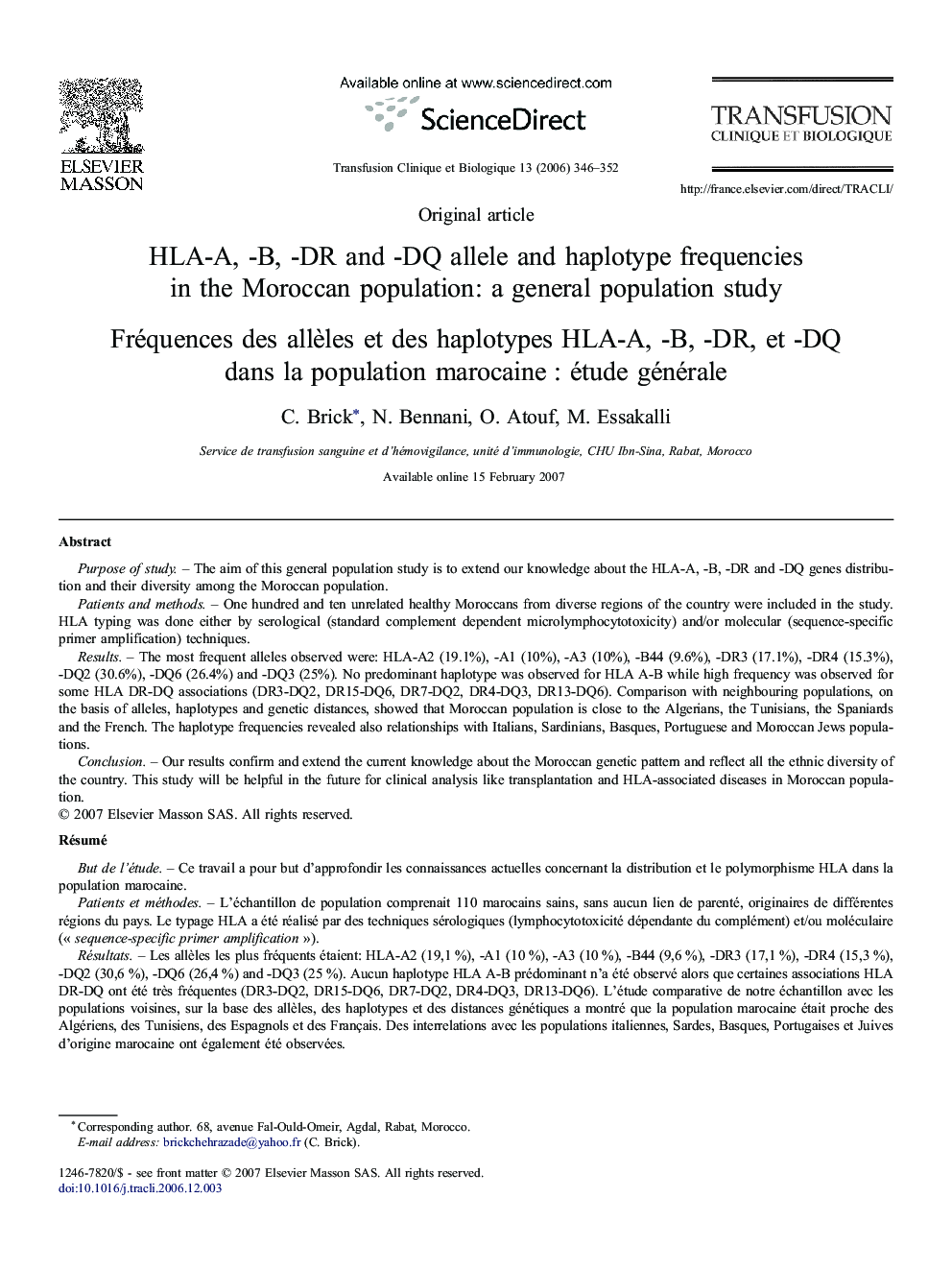| Article ID | Journal | Published Year | Pages | File Type |
|---|---|---|---|---|
| 1105782 | Transfusion Clinique et Biologique | 2006 | 7 Pages |
Purpose of studyThe aim of this general population study is to extend our knowledge about the HLA-A, -B, -DR and -DQ genes distribution and their diversity among the Moroccan population.Patients and methodsOne hundred and ten unrelated healthy Moroccans from diverse regions of the country were included in the study. HLA typing was done either by serological (standard complement dependent microlymphocytotoxicity) and/or molecular (sequence-specific primer amplification) techniques.ResultsThe most frequent alleles observed were: HLA-A2 (19.1%), -A1 (10%), -A3 (10%), -B44 (9.6%), -DR3 (17.1%), -DR4 (15.3%), -DQ2 (30.6%), -DQ6 (26.4%) and -DQ3 (25%). No predominant haplotype was observed for HLA A-B while high frequency was observed for some HLA DR-DQ associations (DR3-DQ2, DR15-DQ6, DR7-DQ2, DR4-DQ3, DR13-DQ6). Comparison with neighbouring populations, on the basis of alleles, haplotypes and genetic distances, showed that Moroccan population is close to the Algerians, the Tunisians, the Spaniards and the French. The haplotype frequencies revealed also relationships with Italians, Sardinians, Basques, Portuguese and Moroccan Jews populations.ConclusionOur results confirm and extend the current knowledge about the Moroccan genetic pattern and reflect all the ethnic diversity of the country. This study will be helpful in the future for clinical analysis like transplantation and HLA-associated diseases in Moroccan population.
RésuméBut de l'étudeCe travail a pour but d'approfondir les connaissances actuelles concernant la distribution et le polymorphisme HLA dans la population marocaine.Patients et méthodesL'échantillon de population comprenait 110 marocains sains, sans aucun lien de parenté, originaires de différentes régions du pays. Le typage HLA a été réalisé par des techniques sérologiques (lymphocytotoxicité dépendante du complément) et/ou moléculaire (« sequence-specific primer amplification »).RésultatsLes allèles les plus fréquents étaient: HLA-A2 (19,1 %), -A1 (10 %), -A3 (10 %), -B44 (9,6 %), -DR3 (17,1 %), -DR4 (15,3 %), -DQ2 (30,6 %), -DQ6 (26,4 %) and -DQ3 (25 %). Aucun haplotype HLA A-B prédominant n'a été observé alors que certaines associations HLA DR-DQ ont été très fréquentes (DR3-DQ2, DR15-DQ6, DR7-DQ2, DR4-DQ3, DR13-DQ6). L'étude comparative de notre échantillon avec les populations voisines, sur la base des allèles, des haplotypes et des distances génétiques a montré que la population marocaine était proche des Algériens, des Tunisiens, des Espagnols et des Français. Des interrelations avec les populations italiennes, Sardes, Basques, Portugaises et Juives d'origine marocaine ont également été observées.ConclusionCette étude générale vient compléter des études ponctuelles et montre que la population marocaine actuelle présente un très grand polymorphisme HLA. Ce travail pourra servir de référence pour les études d'associations HLA et maladie et en transplantation.
